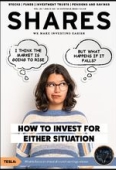Archived article
Please note that tax, investment, pension and ISA rules can change and the information and any views contained in this article may now be inaccurate.
Where are markets heading next and what should investors do?

There is an old saying that no-one rings a bell when the market is at the top, but by the same token neither is there a clear-cut signal to buy when markets reach the bottom.
Yet after a brutal year for stocks – and a particularly tough third quarter – it is beginning to feel as though the worst of the sell-off is in the rear-view mirror and investors should be looking for bargains.
However, if we are wrong and there is more selling to come it’s worth asking where should investors hide until it’s time to dip a toe back in?
ARE MARKETS SET TO REBOUND?
While global stocks are undoubtedly cheaper than they were 12 months ago, we know by now that valuation on its own isn’t enough to spark a rally.
UK stocks especially have looked cheap relative to the rest of the world for several years, but that hasn’t prevented the market from staying cheap.
Investors need to take their lead from one of the following scenarios, or preferably all three: better corporate earnings, a sign that interest rates have peaked and evidence of falling inflation.
US EARNINGS ARE HOLDING UP
Second-quarter aggregate earnings for the S&P 500 index rose a better than expected 6.2% with over 70% of companies beating estimates, while revenues grew by 14% against initial forecasts of 10% according to US firm LPL Financial.
‘Earnings growth of 6-7% doesn’t sound very exciting but given the challenges corporate America has faced we consider the second quarter earnings season a resounding success’ says Jeffrey Buchbinder, LPL’s chief equity strategist.
‘The numerous challenges last quarter included a slowing economy, intensifying inflation pressures, ongoing global supply chain disruptions, and a surging US dollar. Still, corporate America delivered the type of upside investors have grown accustomed to in much easier economic environments.’
As we enter the third quarter reporting season, earnings forecasts have been cut to just a rise of 3% to 4% which suggests there is scope for another round of positive surprises, while fourth quarter earnings are seen rising by between 5% and 6% which is also fairly pedestrian.
‘Using history as a guide, seasonal forces and the mid-term elections should provide a fourth-quarter tailwind’, says Buchbinder, although in the short term ‘the market’s direction will likely depend on when the Fed (US Federal Reserve) signals its rate hiking campaign will end’, he adds. A hotter than expected September jobs report (7 October) dashed hopes of an early pivot by the Fed.
INTEREST RATES AND INFLATION
As it stands, investors are expecting US interest rates to peak at around 5.75% next March and stay there for about six months before gradually easing to around 4.5% by early 2024, according to Bloomberg’s WIRP (World Interest Rate Projections) screen.
However, any sign that the Fed is thinking about cutting rates earlier will send stocks roaring back up again.
That is because the market is a discounting mechanism so a change in consensus expectations of when the Fed will ‘pivot’ and start lowering rates will be factored into valuations very quickly.
The last piece of the puzzle is a fall in headline inflation, which already looks to be under way as supply chain pressures ease along with global freight rates and core goods prices decline.
Oil prices have come down and, despite the recent decision by OPEC+ to reduce production, the base effects of last year’s higher energy prices will start to have a bigger influence on current inflation.
More importantly, the dash to replace Russian gas has resulted in European reserves standing at 90% of capacity which combined with a 10% drop in consumption means the upward pressure on prices should ease.
WHAT ARE THE PROFESSIONALS BUYING?
Stephen Anness, manager of the income-focused Invesco Select Trust - Global Equity Income (IVPG), says he has been ‘eyeing up’ housebuilders and carmakers.
‘To buy them now would be a contrarian move’, admits Anness, ‘but with yields of 7% these sectors are beginning to look enticing within a balanced portfolio.
‘If you have companies on sensible valuations paying a dividend and still growing quickly, then a few lowly-valued companies paying a high income can be attractive – as long as you are confident of being paid. That is the crucial issue.’
Stephen Snowden, head of fixed income at Artemis Investment Management, believes the recent spike in UK gilt yields following the ‘mini budget’ makes this a good time to look at UK corporate bonds.
‘Calling the bottom in markets is simply not possible, but the current yields are big enough to start buying if you are investing with a medium-to-long-term mindset.
‘The UK corporate bond market now yields 6.7%, and it is highly unlikely inflation will stay above that level for long. There is uncertainty ahead, but bargains are never found on sunny days.’
Given the size of the pull-back in the S&P 500 index in the US, investing in an ETF (exchange-traded fund) is probably a good idea if markets are about to rally.
One of the most popular ETFs is the iShares Core S&P 500 (GSPX), which is priced in sterling, while a more nuanced way to play a US rebound is through the equally-weighted Xtrackers S&P 500 Equal Weight Fund (XDWE) which is also priced in sterling but as its name suggests gives each stock an equal weighting to avoid concentration risk.
WHAT COULD SEND MARKETS DOWN AGAIN?
The flip side of the coin – and the cue to be under-invested in stocks until the evidence proves otherwise – is a combination of bad economic news and central bank policy.
While traders and investors continue to search for clues as to when US monetary policy will ease, the central bank has tried its best to make it clear it is determined to ‘get rid’ of inflation by keeping rates higher for longer.
The outcome of this policy is likely to be that less liquid and less well-run companies get pushed into default, which will have a knock-on effect on equities, none of which seems to be factored into markets right now.
In a speech in September 2022, New York Fed chair Jerome Powell made the following comments: ‘We have to get supply and demand back into alignment and the way we do that is by slowing the economy. That’s going to take tight monetary policy for a period of time.
‘Higher interest rates, slower growth, and a softening labor market are all painful for the public, but they’re not as painful as failing to restore price stability and then having to come back and do it. We want to act aggressively now and get this job done and keep at it until it’s done.’
Reinforcing that message, Atlanta Fed president Raphael Bostic said last week in a speech titled ‘Staying purposeful and resolute in the battle against inflation’:
‘There could be short-term pain. That may be the unfortunate cost of reducing inflation. Yet failing to restore price stability now would only lead to worse suffering later.
‘If economic conditions weaken appreciably – for example, if unemployment rises uncomfortably – it will be important to resist the temptation to react by reversing our policy course prematurely.’
WHAT ARE THE LESS OBVIOUS RISKS?
This brings us to the second major risk to markets, that inflation – which is at 40-year highs in many countries – remains ‘sticky’ even though on the face of it prices seem to be falling.
Unfortunately, while the primary causes of inflation may start to fade there are now secondary sources of inflation which are the result of ‘reflexivity’, a concept discussed by financier George Soros in his book The Alchemy of Finance.
In the case of inflation, ‘reflexivity’ means the initial shock of higher food and energy prices is replaced by a response from producers and consumers leading to higher prices for things like services and rent.
There is also a possibility of persistent ‘greenflation’ due to the energy transition as more expensive renewable energy sources are brought in and fossil fuels are phased out.
Sadly, as the saying goes, the cure for high prices is high prices, meaning we get to a point where people and companies simply stop spending and the economy goes into a recession, which by its nature will be disinflationary.
A third factor which could hamper a recovery in markets is the replacement of QE (quantitative easing) with QT (quantitative tightening).
After a decade of worrying about a lack of inflation, which prompted ultra-low interest rates and unconventional central bank intervention every time there was a wobble in markets (the ‘bad news is good news’ scenario), now we are worried about prices rising too fast.
Instead of central banks expanding their balance sheets, and asset prices rising in response – a regime which a generation of traders have become conditioned to and know nothing else – we are moving to a world of liquidity being withdrawn from markets.
Anyone who thinks QT will be painless and is already priced in by markets only needs to look at the mild operation undertaken by the Fed between 2017 and 2019 to see that the effects of withdrawing liquidity are aysmmetrical as bad news becomes plain old bad news again rather than good news because it will lead central banks to turn on the liquidity taps again.
WHAT SHOULD INVESTORS DO?
The classic hiding places during a sell-off are capital preservation funds such as Ruffer Investment Company (RICA) and Personal Assets Trust (PNL), while for investors with more of a risk appetite the Argonaut Absolute Return Fund (B7FT1K7) managed by Barry Norris has shown itself to be a strong performer in weak markets.
The ultimate safety play is to sit in cash or a cash equivalent. When interest rates were close to zero there was no benefit to holding cash, and while inflation was rising its value was being eroded, but with rates heading ever higher investors are beginning to treat it as an asset class in its own right.
Some deposit accounts are offering upwards of 4% which is better than the yield on some stocks without the risk of capital loss.
Even Ray Dalio, the founder of investment giant Bridgewater Associates, has recently rowed back on his long-held view that ‘cash is trash’.
Important information:
These articles are provided by Shares magazine which is published by AJ Bell Media, a part of AJ Bell. Shares is not written by AJ Bell.
Shares is provided for your general information and use and is not a personal recommendation to invest. It is not intended to be relied upon by you in making or not making any investment decisions. The investments referred to in these articles will not be suitable for all investors. If in doubt please seek appropriate independent financial advice.
Investors acting on the information in these articles do so at their own risk and AJ Bell Media and its staff do not accept liability for losses suffered by investors as a result of their investment decisions.

 magazine
magazine









